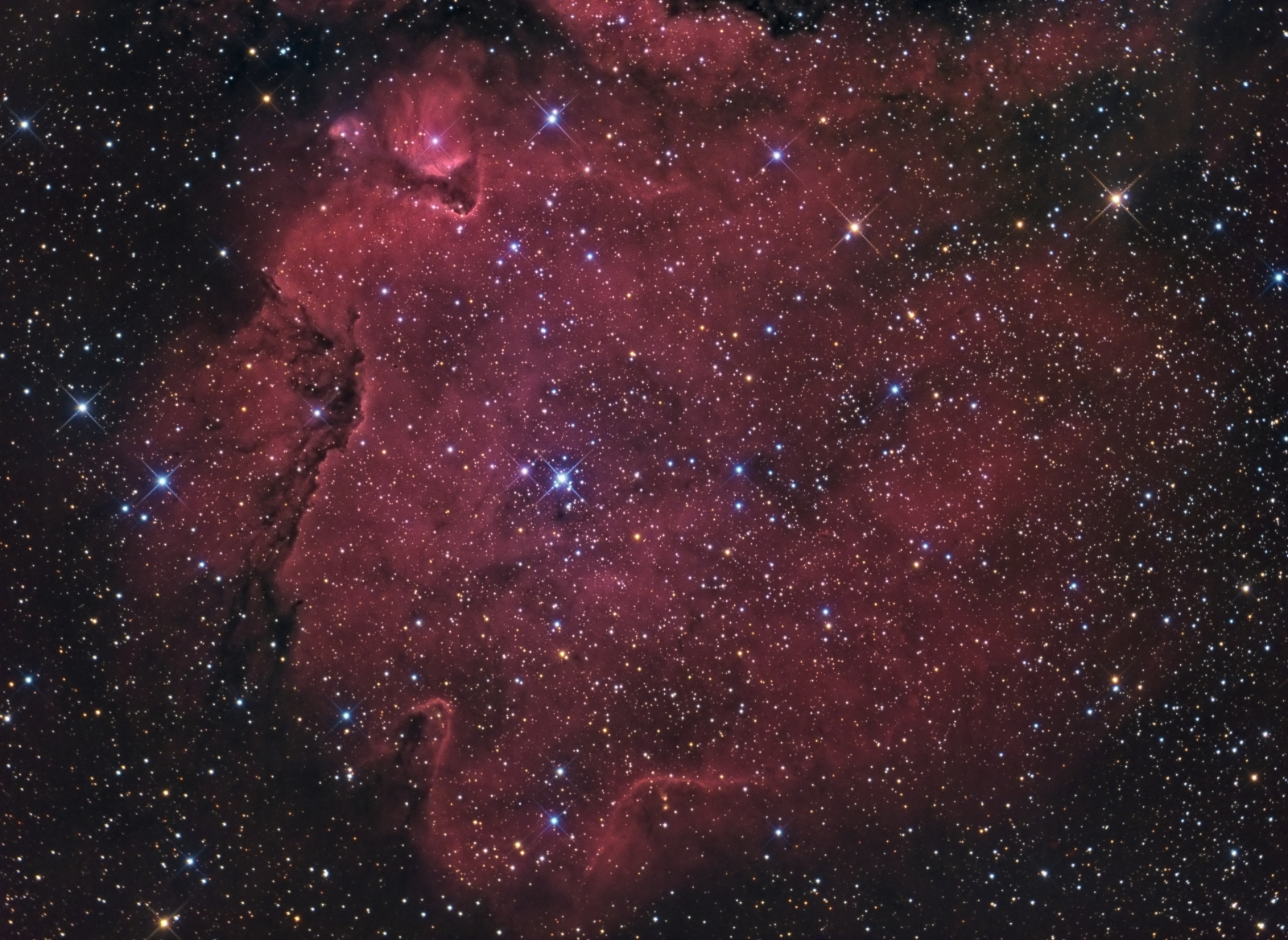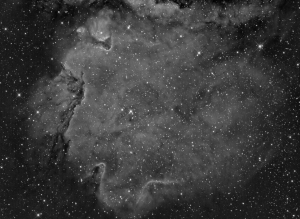Eastern Soul Nebula
 Click image for full size version
Click image for full size version
January 7, 2016
This is my first image post of 2016, so Happy New Year! The Soul Nebula is a large, faint nebula. I have imaged the whole thing previously, so in this image I focused on the eastern portion, or “head” of the region. The whole Soul Nebula is catalogued as Westerhout 5, or W5, and the region shown in this image is W5-E. It contains some young stars (the bright HD18326 near the centre), and two large open clusters Cr34 (centred on HD18326) and Cr33 overlapping it. I can’t say I can really see either of these two clusters, but the stars are colourful and plentiful! This object lies about 7,500 light years from us, in the direction of Cassiopeia.
 The colour image above blends the red, green and blue channels with data collected through a deep red H-alpha filter that lets in just the light emitted by hydrogen atoms. The black and white image at right shows the H-alpha data alone; click on the image to see it full size. The eye is better at picking out detail in black and white images than colour images. The stars are smaller in the Ha version because most starlight is emitted at wavelengths other than H-alpha. The colour and mono versions complement each other, and I hope you enjoy them both.
The colour image above blends the red, green and blue channels with data collected through a deep red H-alpha filter that lets in just the light emitted by hydrogen atoms. The black and white image at right shows the H-alpha data alone; click on the image to see it full size. The eye is better at picking out detail in black and white images than colour images. The stars are smaller in the Ha version because most starlight is emitted at wavelengths other than H-alpha. The colour and mono versions complement each other, and I hope you enjoy them both.
This image took a while to obtain! I started acquiring the H-alpha data in mid-November, 2015, but got clouded out for about 6 weeks straight, so didn’t finish shooting until January 5, 2016.
Tekkies:
SBIG STL-11000M camera, Baader Ha, R, G and B filters, 10″ ASA astrograph operating at f/6.8, Paramount MX. Guided with QHY5 guider and 80 mm f/6 Stellar-Vue refractor. Acquisition and guiding with TheSkyX. Focusing with FocusMax. Automation with CCDCommander. Calibration, cosmetic correction, registration, integration and all processing in PixInsight. Shot from my SkyShed in Guelph, Ontario. Moderate moonlight for Ha and no moon for RGB. Good to very good transparency and average seeing throughout acquisition.
11x15m R, 13x15mG, 13x15mB and 24x20m Ha unbinned frames (total=17hr15m).
HaRGB
Creation and cleanup: R, G and B masters were combined. The RGB ad Ha frames were cropped and processed with DBE. The RGB image was processed with BackgroundNeutralization and ColorCalibration. The NB-RGBCombine Script was applied with default settings to produce a linear HaRGB image. PixelMath was used to boost the blue by adding 10% Ha suing a mask made from the blue channel.
Linear Noise Reduction: MultiscaleLinearTransform was used to reduce noise in the background areas. Layer settings for threshold and strength: Layer 1: 3.0, 0.5 Layer 2: 2.0, 0.35 Layer 3: 1.0, 0.2 Layer 4: 0.5, 0.1
Stretching: HistogramTransformation was applied to make a pleasing yet bright image. TGV Noise was applied and the image was re-stretched to reset the black point.
Synthetic Luminance and H-alpha only
Creation and cleanup: The cleaned up Ha, R,G and B masters were combined using the ImageIntegration tool (average, additive with scaling, noise evaluation, iterative K-sigma / biweight midvariance, no pixel rejection). The Ha master was copied, with the copy used for the Ha-only image.
The following steps were done in parallel on both the SynthL and Ha masters.
Deconvolution: A copy of the image was stretched to use as a deconvolution mask. A star mask was made from the linear SynthL to use as a local deringing support. Deconvolution was applied (75 iterations, regularized Richardson-Lucy, external PSF made using DynamicPSF tool with about 25 stars; local deringing at 70% and global dark deringing at 0.03).
Linear Noise Reduction: MultiscaleLinearTransform was applied to reduce the noise. Layer settings for threshold and strength: Layer 1: 3.0, 0.5 Layer 2: 2.0, 0.35 Layer 3: 1.0, 0.2 Layer 4: 0.5, 0.1
Stretching: HistogramTransformation was applied using STF Autostretch settings. TGV Noise was applied and the image was re-stretched to reset the black point.
HDR Multiscale Transformation: HDRMT was applied at a 6 pixel scales using a mask to protect stars. LHE was applied at scales of 50 and 150 using the same star mask (strength 0.5 for both).
Combining SynthL with HaRGB:
The luminance channel of the HaRGB image was extracted, processed and then added back into the HaRGB image as follows:
1. Extract luminance from the HaRGB image.
2. Apply LinearFit using SynthL as the reference.
3. Use ChannelCombination in Lab mode to replace the HaRGB’s luminance with the fitted luminance from step 2.
4. LRGBCombine was then used to make a SynthLHaRGB image.
Final Processing
SynthLHaRGB: A range mask for the brightest highlights minus stars was made by subtracting a star mask from a range mask. The highlights were sharpened slightly with UnsharpMask. Overall contrast and brightness were increased slightly with the Curves tool.
Ha only: The highlights were sharpened slightly with UnsharpMask. Overall contrast and brightness were increased slightly with the Curves tool.
Image scale is about 1.1 arcsec per pixel for this camera / telescope combination.






Amazing photo, thanks for sharing!
Ossim!